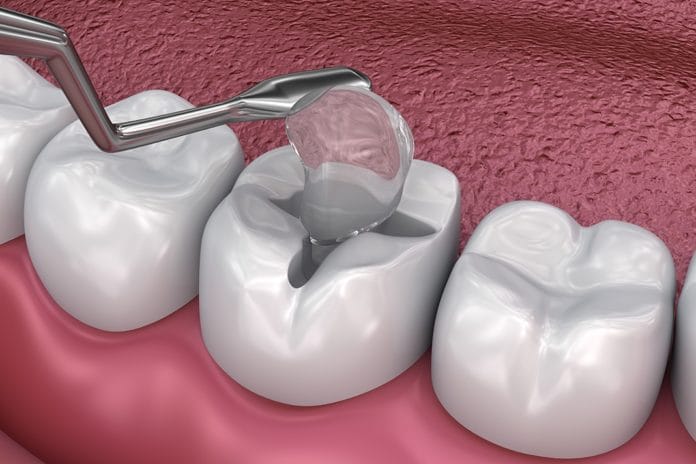The dental community is in a continual search for better dental materials and treatment options to provide an affordable, durable, and improved quality of care for its patients. The Oregon Health and Science University (OHSU) School of Dentistry has recently developed a filling material that is “two times more resistant than standard filling” materials presently used in dentistry.1
Currently, the traditional restorative materials used in dentistry have a five- to 15-year life span and are at risk for a variety of failures depending on the material and conditions under which the filling is placed. The restorative material developed by OHSU in Portland contains an additive called thiourethane. Thiourethane is “a compound used to make car bumpers strong and protect wood decks.”1
Studies have shown that combining thiourethane with resin-filling material results in increased strength and durability.
The variety of dental restorative materials and applications are plentiful and effective, but they are not flawless. The chief concerns are cost, strength, and long-term stability.
The addition of thiourethane to dental resin composites may address these concerns. The alteration to the resin composites developed by OHSU has effectively reduced the stress and fracture probability by 35 percent.5 With the addition of thiourethane, the resin composite’s viscosity increases and may challenge the clinical application.
In addition, OHSU is also developing a dental adhesive to be used in combination with the thiourethane composite that increases the longevity of the compound composite restoration.5 Although the thiourethane resin composite and dental adhesive may still be in their developmental stage, they may be a future alternative to a cost-effective and long-term dental restoration treatment option.
Restorative Materials Review
Traditionally, the dental filling materials used in dentistry are resin composite, silver amalgam, gold, ceramic, and glass ionomer. Although these materials have been effective in restorative treatment, each material has its positive and negative properties.
A review of where dentistry stands with traditional restorative materials can be reviewed below.
Resin Composites− Resin composites are a tooth-colored filling material most commonly used in dental restorations. The composite material is a durable material that can be placed on anterior and posterior teeth in need of restorative treatment. Although its tooth color makes it “cosmetically appealing,” it is only resistant to fracturing in small to midsized fillings.2 Large-sized fillings can be quite unstable and subject to fracturing.
Composite resins are chemically bonded to the tooth structure, thus requiring less tooth preparation than other materials such as silver amalgams. But they do require increased chairside preparation during placement. Furthermore, they are less durable with a life expectancy of only five years before possible failure and need for replacement.3 Finally, composite resins are also more expensive than other alternative restorative materials and may not be fully covered by dental insurance, resulting in an increased out-of-pocket expense for the patient.
Amalgam− Dental amalgam is a silver-colored restorative material that contains a combination of metals, including mercury, silver, copper, and tin.2 Silver amalgams were more commonly in use prior to the development of composite resin fillings, but are still used in dental offices today. Although amalgam restorations are not as eye-pleasing as alternative restorative materials and may cause discoloration to the surrounding tooth structure, they are an affordable tooth restorative option.
Amalgams are durable and have a life-expectancy of anywhere from 10 to 15 years. However, due to the mechanical bond placement of the amalgam filling material, such fillings require “the destruction of healthy tooth structure during placement” and are most effective in larger restoration placement as opposed to smaller restorative treatment.3 The properties of amalgam cause the material to expand and contract from the temperature variation in the oral cavity, thus posing a higher risk for marginal leakage and recurrent decay.
For many years, there had been concerns about the vapors released by the mercury contained in the amalgam restorations and its effects on the patient’s organs, typically the brain, the lungs, and the kidneys. However, research has shown that the mercury contained in amalgam restorations releases low-level vapors absorbed by the lungs and have minimal to no adverse effects. Based on scientific studies, the Food and Drug Administration considers amalgam restorations to be safe for adults and children under the age of six.3
Gold− Gold is another means of a restorative treatment option that is currently used because of its durability and strength. Gold restorations are resistant to corrosion in an enzyme enriched environment that can invite corrosion to metallic materials.2 Although gold restorations are durable, with a life expectancy of 10 to 15 years, they require multiple office visits to be placed, and the cost can be up to ten times that of an amalgam or composite restoration.
Gold restorations are mostly used for inlays, onlays, and crowns, but they can be used as a restorative option for smaller caries. Similar to amalgam restorations, gold requires a mechanical bond, and if placed near an amalgam restoration it can result in a “galvanic shock.”3 Galvanic shock, also known as “dental galvanism,” is a “production of galvanic current in the oral cavity due to the presence of two or more dissimilar metals in dental restorations that are bathed in saliva.”4 The galvanic reaction can result in irritation or pain to the dental pulp.
Ceramic− Ceramic or porcelain is a restorative material that is typically placed for anterior restoration because of its resistance to stain and its aesthetically pleasing appearance. Ceramic restoration has a long life-expectancy of 15 years or more, but ultimately at a high cost and with an abrasive effect on surrounding structures.3
Glass ionomer− Glass ionomer is a combination of acrylic and a special glass material that is weaker than a composite resin. Consequently, it has a life expectancy of only five years. The glass ionomer restorative material is prone to fracture and typically used for restorative treatment at the gumline. However, glass ionomers are also used for primary restorations in children due to its fluoride release.3
Before you leave, check out the Today’s RDH self-study CE courses. All courses are peer-reviewed and non-sponsored to focus solely on pure education. Click here now.
Listen to the Today’s RDH Dental Hygiene Podcast Below:
References
- Dental Fillings could Last Twice as Long. (2019, March 4). ScienceDaily. https://www.sciencedaily.com/releases/2019/03/190304145429.htm
- Dental Filling Options. (n.d.). American Dental Association. https://www.mouthhealthy.org/all-topics-a-z/dental-filling-options
- WebMD Editorial Contributors. (2021, October 31). Dental Health and Tooth Fillings. WebMD. https://www.webmd.com/oral-health/guide/dental-health-fillings#1
- Dental Galvanism. (n.d.). The Free Dictionary. https://medical.dictionary-thefreedictionary.com/dental+galvanism
- Fugulin, A.P., Sundefeld, D., Ferracane, J.L., Pfiefer, C.S. Toughening of Dental Composites with Thiourethane-modified Filler Interfaces. Scientific Reports. 2019; 9; 2286. https://www.nature.com/articles/s41598-019-39003-w











